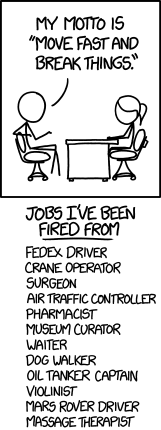Developer Mindset
An attempt to get you into a good mood for development in the Atem-Project.
Never finished. Additions welcome.
Be Autonomous
Learn how things are done in Atem by reading code and documentatin and by understanding it for yourself. If you have trouble understanding the JavaScript of Atem, go to MDN (nowhere else) and learn the syntax and API. Don't let us find the documentation for you. It doubles the time wasted for the task and you learn less.
If there's no documentation and you have a hard time understanding something, try to formulate a most informed question. If that did not help you already we'll be glad answering you.
If you just had a fundamental breakthrough in understanding something in Atem, be a hero and write a short article to share in the Concepts or Manuals section.
Look at Atem-Project in its entirety
Always consider the whole Atem-Project, not just your specific problem at hand. Many solutions may be better/leaner if applied in a lower level of the project. Before you start to hack a fix around some bad behavior of a dependency, consider fixing the dependency.
This is important, because of the subproject-structure of Atem it is likely
that you think fixing the hindrance is to much effort
or whatever. But
in fact it will in the most cases improve the project and make it more
complete. Also, you will learn more about the project structure and
eventually start taking part in forming the lower level structures of the
project.
A good starting point to fix lower level code could be to make a clean sub-class of the module in question, within your project, and implement the changes needed there (or do monkey-patching if there's no better way). That way, discussing the upstreaming of the changes will be easy and straight forward and you can keep on going without a pull request, maybe file an issue and point to the changes needed.
For the project, the most valuable thing you can give is a pull request. But this kind of contribution can slow things down; because there is peer review involved: people reading the code, discussions, requests for changes etc. If, for whatever reason you lack the time for a proper pull request process, it is OK to do it as described above. Important is that you don't take the foundation you build upon as given and work around weaknesses, instead, improve the foundation.
Write code for other people to read
When writing code try to be short and precise but not cryptic. The most important function of your code is to be read by other developers, write code as if you want to explain something to a human being.
Break Stuff
To make things better you got to break things. Don't be afraid to break stuff, it's an opportunity for you to learn and it's probably the right way to achieve your goal.
We use the concept of private
properties/functions/methods—marked with
an _ underscore as the prefix of a name—that's invaluable when refactoring
code. Be reckless when changing private APIs, be careful when changing public
APIs. Use grep, consider all users of a public APIs, see how the public APIs
are used. By default, add private APIs, only add public APIs when they are
really needed in the very moment. Don't presumably add new public APIs,
unless it's really core to how your module is to be used.
After breaking things you should still try to make a Pull Request that does
not break things too much
, or at least inform us about things you broke
in your PR. The point is that your result will be better if you did break
stuff in the process.
